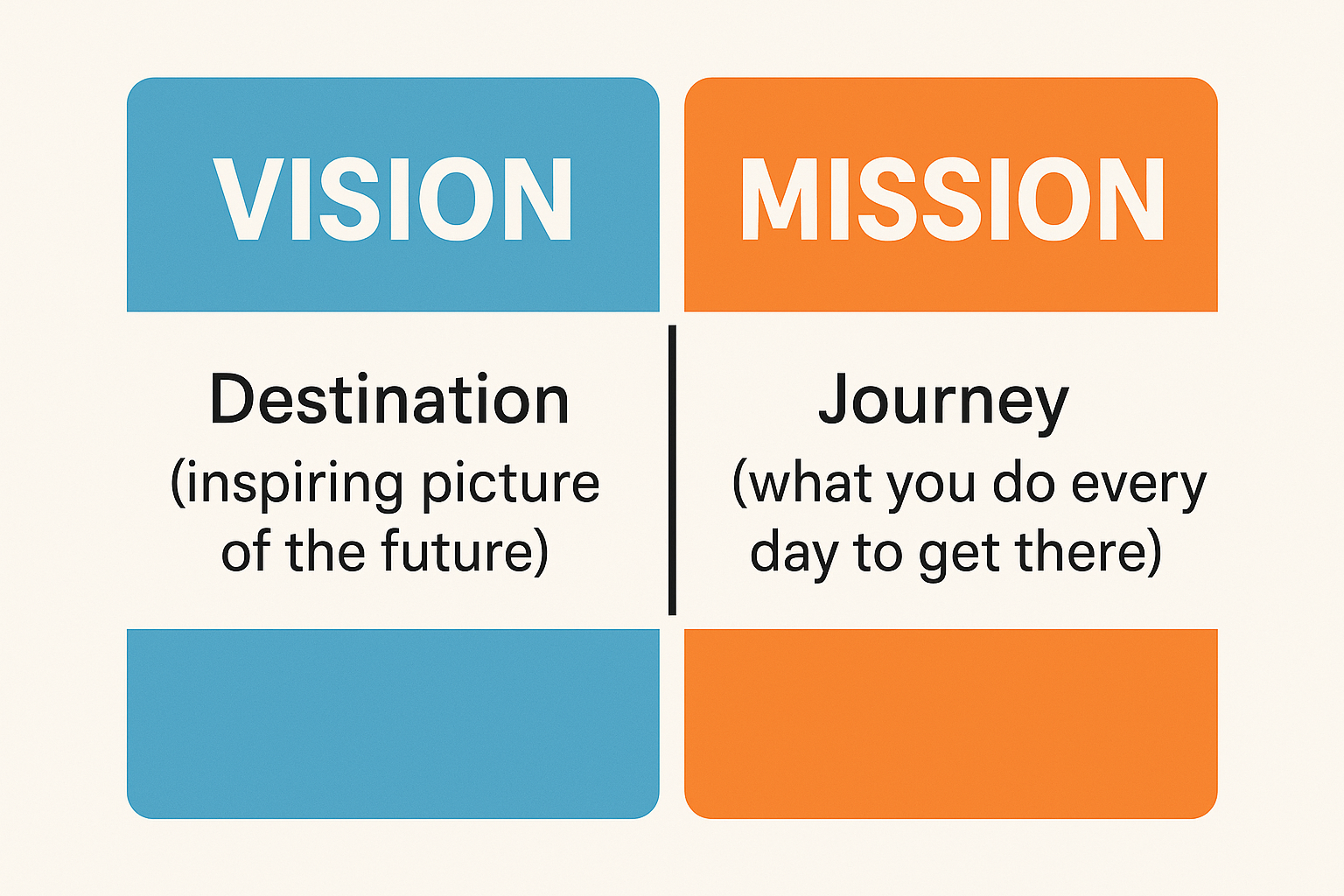
In business, staying aligned with your mission and vision is essential. They provide clarity, focus, and a renewed sense of purpose. But what exactly is the difference between the two?
Through my research, I’ve found a simple way to think about it:
- Vision = Destination – the inspiring picture of the future you want to create.
- Mission = Journey – the daily actions and commitments that move you toward that future.
When you clearly articulate both your vision (where you’re headed) and your mission (how you’ll get there), you can then set purpose-driven goals to bring your vision to life. Goals provide the focus and precision needed to stay on track, even in times of uncertainty.
In this article, we’ll explore vision and mission in more depth, examine how to set purposeful goals, and show how living your mission while striving toward your vision creates the long-term resilience every business needs to thrive.
Vision: Defining Your Destination
A vision is about the future you aspire to create. It answers the question: “Where are we going?” A strong vision is inspirational and forward-looking, painting a picture of the long-term outcome you want to achieve. When shaping your vision, think big – where do you want to be in the next 5 to 10 years?
Your vision should focus on the ultimate impact you want to make in the world and the destination you want to reach in life. For example, my vision is to inspire and empower others through impactful communication, strategic leadership, and innovative technology solutions – building a career as a sought-after professional speaker, a results-driven project manager, and the founder of a thriving software development company that creates meaningful value for clients and communities worldwide. This is the direction I want to move in.
A compelling vision is long-term by nature. It cannot be achieved overnight; it requires time, energy, and persistence. But by keeping your vision clear and alive, you stay focused on where you’re headed, even when the journey gets challenging.
Mission: Defining Your Purpose in Action
A mission explains what you do, who you serve, and how you do it. It answers the questions: “Why do we exist?” and “What are we doing right now?” Unlike a vision, which looks far ahead, a mission is practical and action oriented. It guides your day-to-day decisions and keeps you aligned with your core values and purpose.
A mission focuses on the present to medium-term, clarifying the activities and commitments that drive your progress. As my friend Marc Haine often asks: “What big, expensive problem do you solve?” Answering this question helps define your mission by making it clear what value you bring and why it matters.
For example, the mission of Toastmasters International is: “We empower individuals to become more effective communicators and leaders.” This statement is simple, action-focused, and easy to connect with – an effective mission in action.
Vision, Mission, and Goals: How They Work Together
Your vision is the “where” – the future state you want to create, a destination that inspires.
Your mission is the “why and how” – the purpose behind your work and the actions you commit to every day to move toward that vision.
Your goals are the “what” – the specific, measurable steps that bring your mission to life and gradually move you closer to your vision.
Think of it this way:
- The vision is the mountaintop.
- The mission is the chosen path and approach to climbing.
- The goals are the steps you take, one after another, to reach the summit.
Without goals, a vision remains only a dream, and a mission is just words. Goals provide the focus, accountability, and momentum needed to transform intention into measurable progress. They serve as milestones, ensuring that every action is aligned with your mission and steadily advancing you toward your vision.
For example, my personal mission is to lead with integrity, excellence, and purpose—empowering individuals to take ownership of their personal and professional growth. Through my work as a professional speaker, author, project manager, and Toastmasters leader, I strive to create impactful experiences that foster self-directed leadership, effective communication, and continuous learning. By sharing knowledge, delivering actionable insights, and motivating others to embrace clarity, accountability, and resilience, my aim is to build a legacy of leadership that inspires people to lead themselves with confidence, serve their communities with purpose, and pursue excellence in every endeavor.
How to Set Purpose-Driven Goals
Once your vision defines the destination and your mission outlines the path, goals become the bridge that carries you forward. But not all goals are equal. To stay aligned and make real progress, your goals must be purpose-driven – rooted in your mission, moving you closer to your vision, and reflecting your values.
Here are key steps to setting purpose-driven goals:
- Start with Your “Why.”
Before setting a goal, ask: “Why does this matter?” Goals without purpose become checkboxes. Goals tied to your deeper mission inspire commitment and resilience. - Align with Vision and Mission.
A purpose-driven goal should support your mission today while pushing you toward your long-term vision. If a goal doesn’t move you in that direction, it’s a distraction. - Make Goals SMART.
Goals should be Specific, Measurable, Achievable, Relevant, and Time-bound. Clarity eliminates ambiguity and provides a roadmap for progress. - Break Down Big Goals into Milestones.
A vision can feel overwhelming, but breaking it into smaller, achievable steps keeps momentum high. Each milestone becomes a win that builds confidence. - Stay Flexible but Accountable.
Circumstances will change, but purpose-driven goals give you a compass to adjust without losing direction. Review regularly, refine when necessary, and hold yourself accountable.
When you set goals that are anchored in purpose, every step you take has meaning. Instead of simply chasing numbers or tasks, you’re building toward something greater – a future defined by your vision and sustained by your mission.
Conclusion
Purpose, precision, and progress in business all come down to clarity of direction. A clear vision paints the picture of the future you aspire to create, inspiring people with a destination worth striving toward. A well-defined mission grounds that vision in the present, outlining who you serve, what you do, and how you deliver value. And goals translate both into action, breaking the journey into measurable steps that turn intention into results.
When vision, mission, and goals align, businesses move with focus and purpose. The vision ensures you never lose sight of where you’re headed, the mission keeps you true to why you exist, and goals provide the precision to measure and adjust along the way. Together, they form a roadmap that not only guides decisions but also fuels momentum, resilience, and long-term success.


Leave a Reply